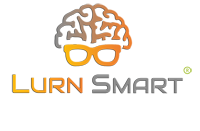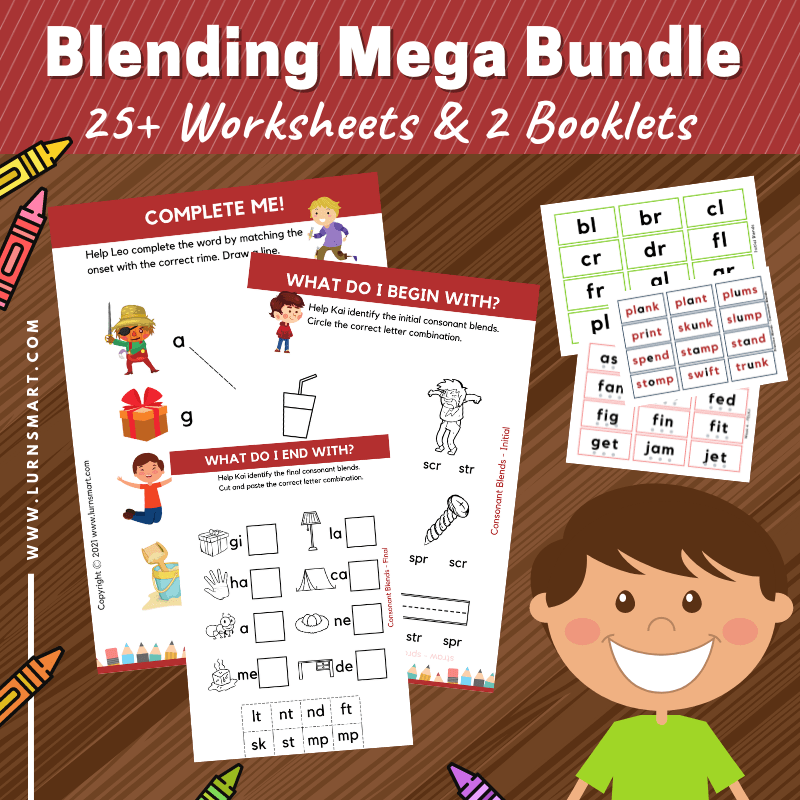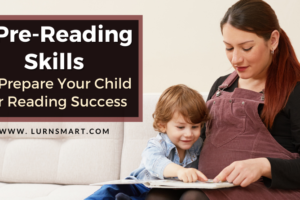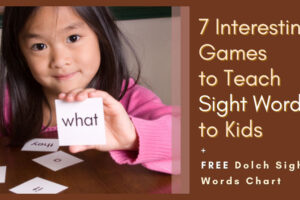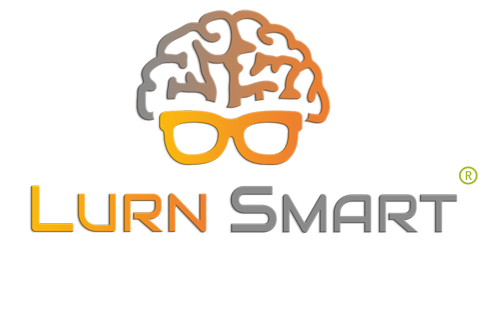6 Fun Blending Sounds Activities + Step-by-Step Guide to Teach Blending
- Categories Early Learning, Reading
- Tags Reading time 10 min
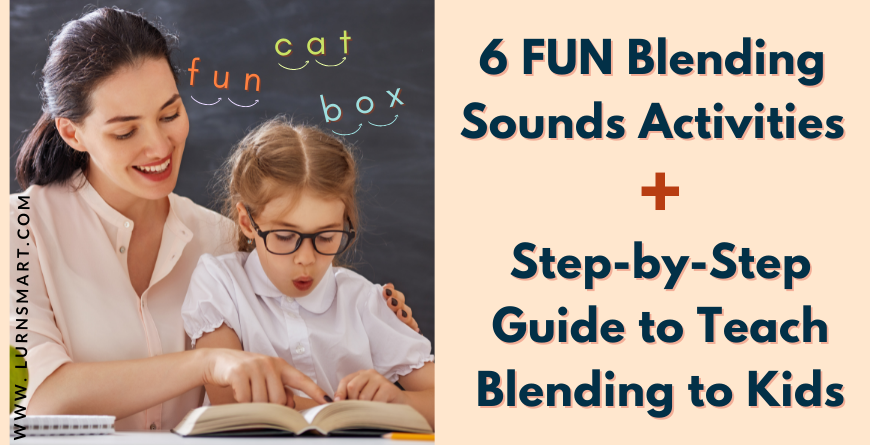
Blending sounds activities can make learning the concept of blending exciting and interesting!
In this post, I’m going to share with you 6 fun blending sounds activities, and also provide you with a step-by-step guide to teach your child this important reading skill easily.
If you are in a hurry, simply click on the link that is more relevant to you to get to a particular section of the blog post. If not, just enjoy reading the whole post 🙂
- What is blending?
- 3 simple ways to INTRODUCE the concept of blending
- The ultimate 4-step process to TEACH blending
- 6 fun blending sounds activities to PRACTICE blending
- Tips to OVERCOME common blending DIFFICULTIES in kids
What is Blending?
Blending is an important reading skill that helps children decode words, including unfamiliar words easily.
Here’s an example!
three letters in the word represent /b/ /a/ /t/ and then joins those three sounds
This ability to put sounds together to read a word is called ‘blending.’
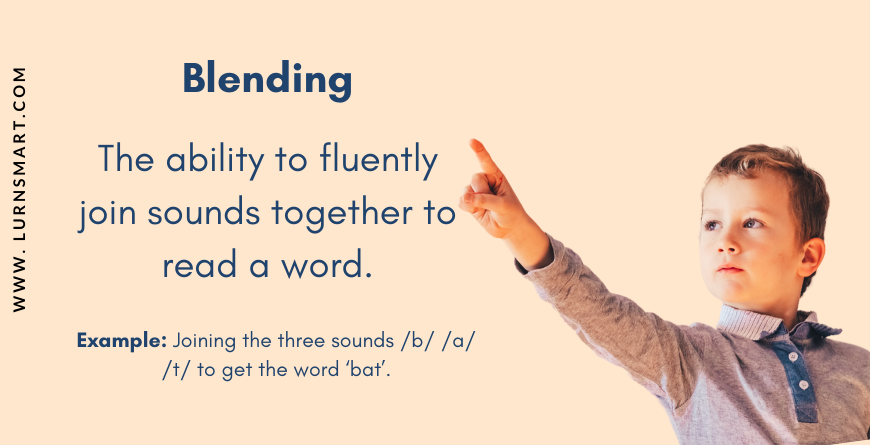
3 Simple Ways to Introduce the Concept of Blending Sounds:
Teaching the concept of blending sounds to young readers can seem daunting but when you include ‘blending’ in your every daily interaction and conversation with your child, it becomes super simple and easy!
Here are 3 simple ways to introduce blending sounds to your child:
1.ORAL BLENDING:
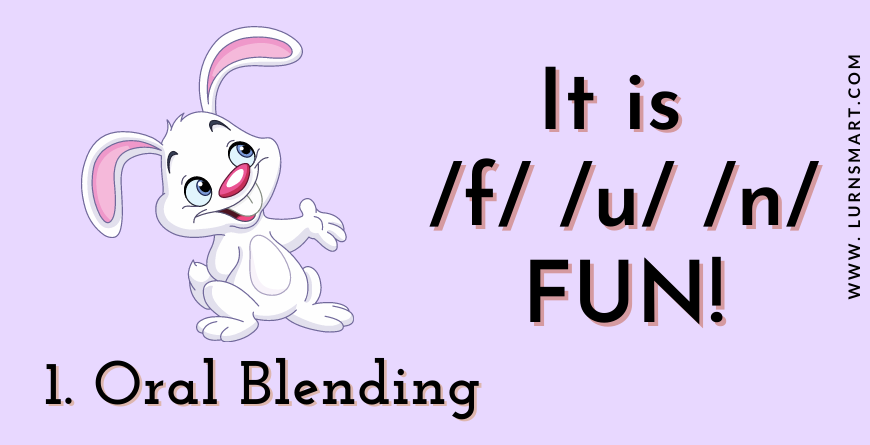
If your child can string sounds together orally to form words, doing so in print becomes a piece of cake. So starting early, pick a couple of words a day to segment and blend.
Here are some examples!
Look at the /s/ /u/ /n/.
There’s an /a//n//t/.
Here’s your /s//n//a//ck/.
A simple tip is not to overdo but to keep things simple and playful. So sound like a robot or a rat and get your child giggling!
Note: If you are new to phonics, check out my video on the 44 Phonics Sounds in English and also make sure you read my post Fun Phonemic Awareness Activities to Develop Sound Awareness Skills to learn about segmenting, which is another important reading skill that your child needs to master to become a strong reader and speller.
2. POINT AND SWIPE:
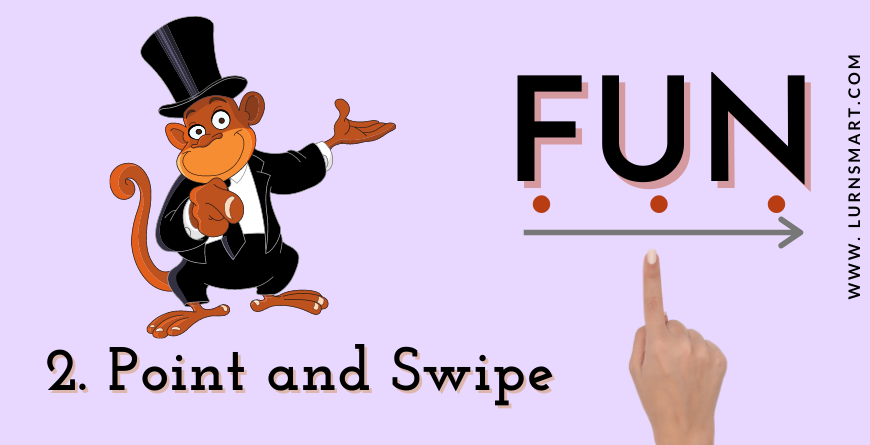
Apart from your daily conversations, pick a couple of words to segment and blend during your daily reading time.
When you do this, always remember to use your pointer finger to point to the letter you are sounding out and swipe under the word when you blend the sounds together.
This will give your child lots of opportunities to visually see how sounds are strung together to form words.
3. SLOW DOWN AND STRETCH:
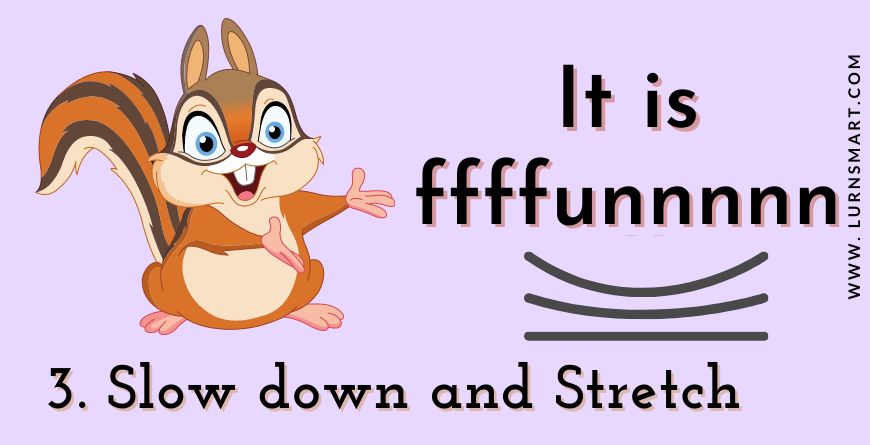
When you pick words to segment and blend during the day or during your daily reading time, remember to slow down and stretch.
Especially when you first introduce the concept of blending to your child, a simple tip is to pick words that are made up of ‘continuous sounds’ such as /r/ /f/ /s/ as opposed to ‘stop sounds’ such as /b/ /k/ /d/.
This is because continuous sounds are easy to blend while stop sounds can be a bit challenging. Moreover, when you slow down and stretch stop sounds, chances are, you might end up mispronouncing the sounds.
Here’s an example!
/cuh/ /a/ /tuh/ is ‘cuhatuh’ and not ‘cat’.
More on continuous vs sounds at the end of this post!
The Ultimate 4-Step Process to Teach Blending Sounds:
Once you get your child familiar with the concept of putting sounds together, the next step is to help your child to practice blending sounds to read words in English.
Note: Some kids, especially kids 4 and under might not be ready for formal teaching yet so instead of forcing them, pick a game from the 6 fun blending sounds activities mentioned in this blog post to teach blending using the 4-step process in a playful way!
STEP 1: VC/CV BLENDS:
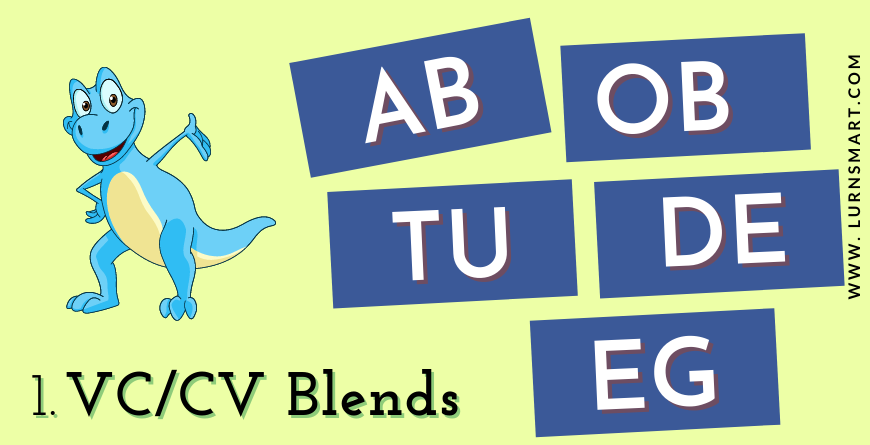
As I already mentioned at the beginning of the post, some children get the concept of blending sounds to read words easily while others might need some help and practice.
If your child sounds out the letters in the word ‘van’ correctly as /v/ /a/ /n/ but ends up saying ‘Pat’, don’t be surprised or discouraged.
It is normal for beginning readers to do so!
When this happens, take a step back and help your child learn how to blend two sounds first—it can be a vowel and a consonant (VC blend) or a consonant and a vowel (CV blend).
Here are some examples!
/a/ /t/ = at (VC Blend)
/p//o/ = po (CV Blend)
/m//a/ = ma (CV Blend)
STEP 2: CVC WORDS:
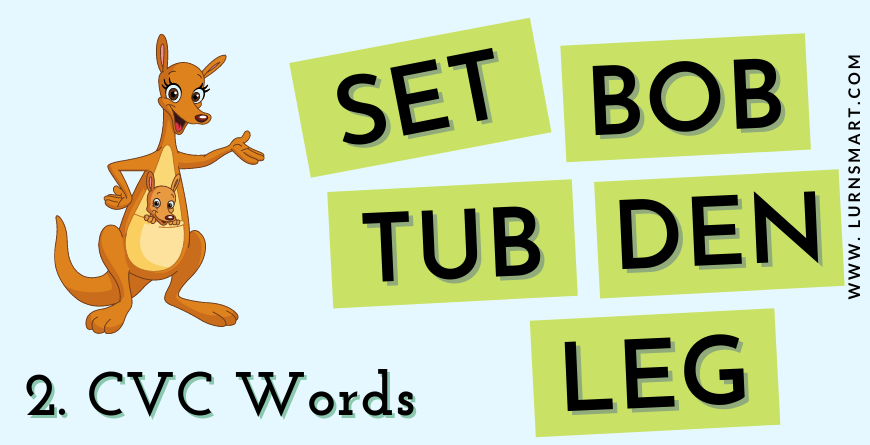
Once your child learns how to blend 2 sounds, it is time to include the third sound. So introduce simple 3-letter words that fall into the CVC (consonant-vowel-consonant) word pattern.
Here are some examples!
/m/ /a/ /t/ = mat
/k/ /a/ /t/ = cat
/s/ /a/ /t/ = sat
You can check out our FREE CVC Onset & Rime Word Book to help your child practice reading word families!
However, be cautious while doing so, coz’ children who are introduced to word families at the beginning of their reading journey are more likely to get into the habit of word-guessing!
We don’t want that to happen!
So use this FREE resource sparingly. I suggest, instead of going by word families, you can jumble up the cards and encourage your child to sound out each letter in the word and blend them smoothly to read the word!
STEP 3: CONSONANT BLENDS:
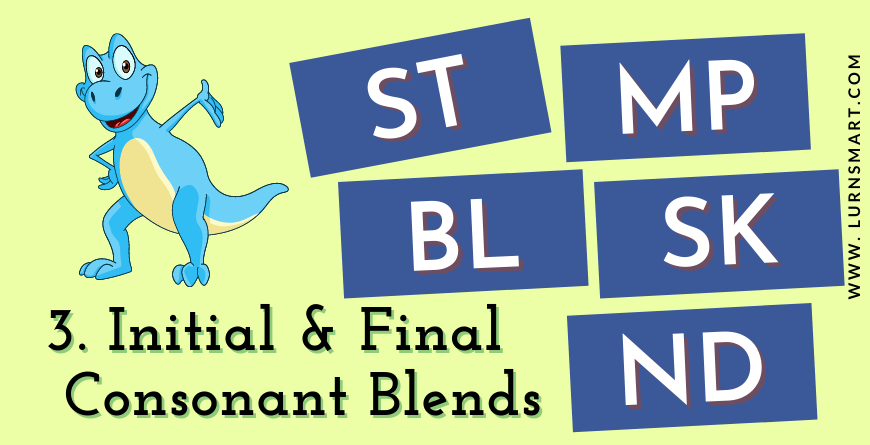
If your child can decode simple 3-letter words, it is obvious that the next step is to help your child decode words that are 4, 5, 6 letters long.
And what makes it possible for your child to read big words is learning about consonant blends!
So what are consonant blends?
Consonant blends are two or more consonants that appear next to each other at the beginning or end of a word, when blended together, each sound in the blend is heard.
Let’s see some examples!
Initial Blends: ‘st’ as in the word ‘stem’
Final Blend: ‘nd’ as in the word ‘land’
Initial & Final Blends: ‘str’ and ‘nd’ as in the word ‘strand’
Note: When consonant blends appear at the beginning of a word, they are called ‘initial consonant blends’ and when they appear at the end of a word, they are called ‘final consonant blends’.
Check out our FREE Consonant Blends Chart for the list of beginning and final consonant blends to teach your child!
By the way, if you want to learn about the difference between blends and digraphs, then check out my blog post A Complete Guide to Teach Digraph Sounds to Kids + Fun Activity Ideas in which there is a section that talks about the difference between these two important terms.
STEP 4: WORDS WITH CONSONANT BLENDS:
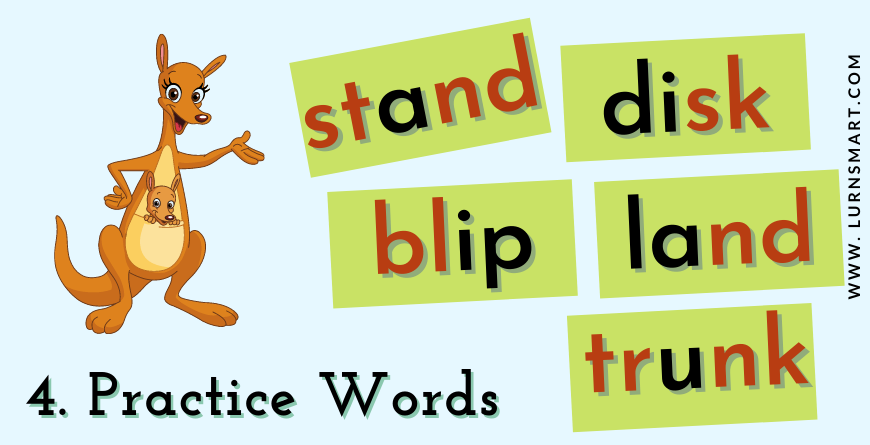
Now that your child is familiar with consonant blends, decoding longer words is a piece of cake!
For instance, to decode a 5-letter word, instead of sounding out all the 5 letters and then blending them to read the word, your child can just identify the consonant blends and then blend the consonant blends along with the other single letter sounds in the word to read.
Here’s an example!
By the way, if you are looking for ways to help your child learn this important reading skill through fun hands-on blending sounds activities, then check out our Phonics Blending Mega Bundle for kids. This bundle includes:
- CV/VC blends list to practice blending two letter sounds.
- CVC blends word list to practice blending 3-letter words
- Initial and final consonant blends list to practice consonant blends and clusters
- Consonant blends word list to practice reading words that are made up of initial and final consonant blends.
- 25+ worksheets to practice blending and segmenting.
6 Fun Blending Sounds Activities to Practice Blending:
Now that you have learned how to teach blending sounds to your child, it is time to explore fun ways to help your child practice this key skill.
Here are 6 interesting blending sounds activities to help your child master the concept of ‘blending’ easily.
The best part about these blending activities is that you hardly need anything!
The only requirement, however, is, your child must be familiar with the letter sounds.
1.SOUND AND DRIVE:
If you have a little car lover, this is one of the must-try blending sounds activities that you got to play with your child!

Things you need:
- Toy cars
- Chalk
- Whiteboard and dry erase marker (optional)
Instructions:
Using the chalk write 2-letter blends, 3-letter words, or words with consonant blends on the floor and let your child use his or her favorite car to drive to each letter while saying the sound. And then speed up to give you the word.
Vroooom!
2. POUND AND SOUND
Children love to pound!
So get ready to have some fun with this blending sound activity!
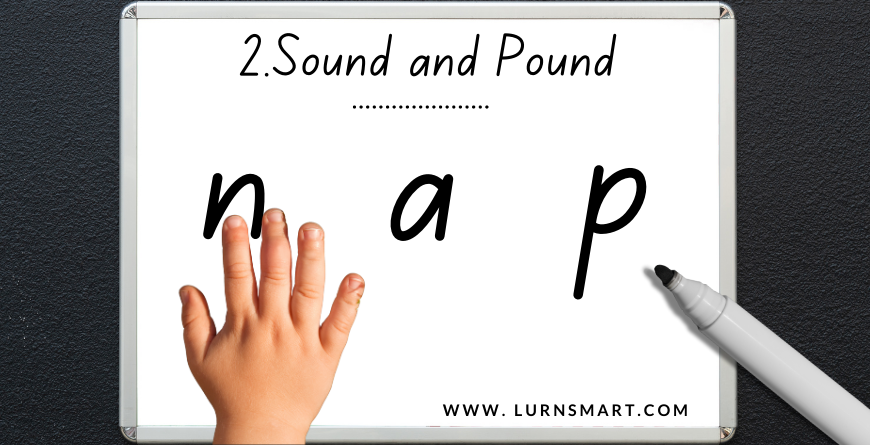
Things you need:
- Chalk
- Whiteboard and dry erase marker (optional)
Instructions:
Using the chalk write 2-letter blends, 3-letter words, or words with consonant blends on the floor.
Now pretend that each letter is a bug, let your child pound each letter while saying the sound, and then pretend to sweep out the bugs as he or she rubs off the letters to say the word.
Child: /s/ /e/ /nd/ = send
3. SOUND AND SLIDE
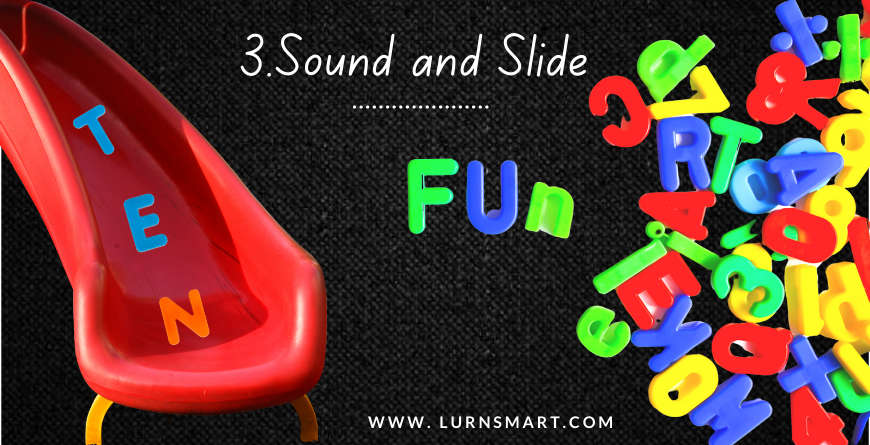
If your child has a kid’s slide at home then this is one of the blending sound activities that you can consider playing with your child!
Things you need:
- Kid’s slide or a DIY slide made out of cardboard or books
- Magnetic letters
Instruction:
Give a handful of magnetic letters to your child.
Call out the letters in the word that you want your child to learn.
Let your child slide down each letter while saying the sound and finally let your child slide all the letters together while saying the word.
Parent: s-i-t
Child: /s/ /i/ /t/ = sit
4. SOUND AND BEAD:
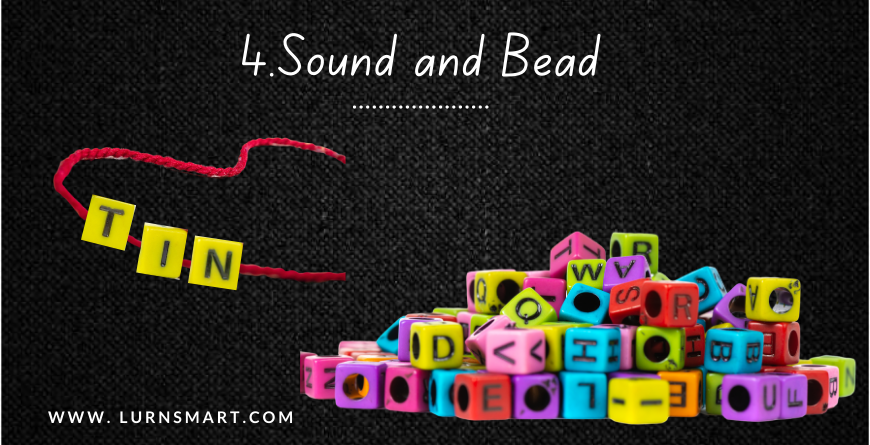
Stringing beads is a great fine motor skill activity!
And stringing alphabet beads together can make learning the concept of blending interesting!
Things you need:
- String
- Alphabet beads
Instruction:
Stretch out and say a word.
Let your child identify the sounds and their corresponding letters in the word.
Then string the correct letter beads together while saying the sound.
NOTE: If your child struggles with the concept of blending, you can put two or more knots on the string, and for each sound encourage your child to touch a knot. Then have your child stretch and blend the sounds while running his/her fingers from one knot to the other.
5. HEAR AND ACT
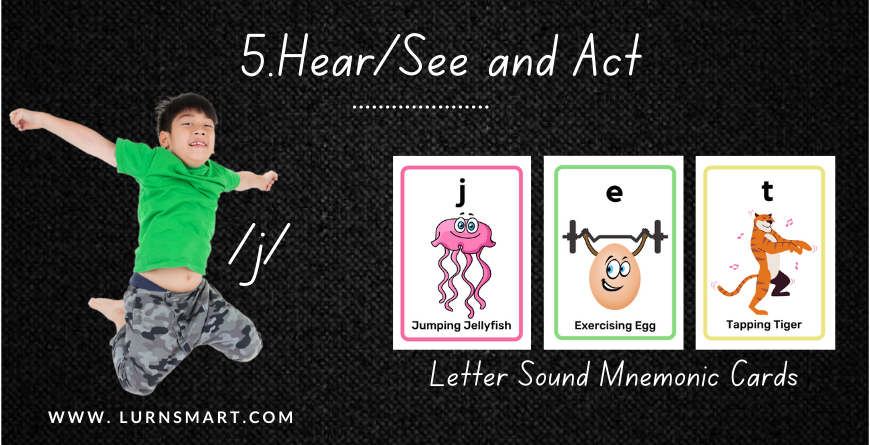
Playing blending sound activities can’t get more interesting when it involves some silliness!
If you have taught letter sounds using our Phonics Letters Sounds Songs & Stories Booklet, your child would have learned a silly action for each letter sound.
So use those silly actions or you can come up with your own silly action for each sound to play this game!
Things you need:
- Whiteboard
- Dry erase marker
- 2-letter blend cards or word cards (optional)
Instruction:
To play this game, write a 2-letter blend or a 3-letter word, or words with consonant blends on the whiteboard using a dry erase marker.
Let your child see the word and identify the individual sounds in the word. Then do the silly action for each sound and say the sounds quickly to identify the correct word.
NOTE: If you have bought our Phonics Mega Blending Bundle or have enrolled in our LURN Phonics Kid’s Reading Program, you can use the 2-letter blend cards or word cards.
Example:
Parent: (shows the word card) MAT
You can also challenge your child further by saying the letters in the word and letting your child identify the sound, do the action and finally identify the word for you.
Example:
Parent: A-M
6. HOP AND SOUND
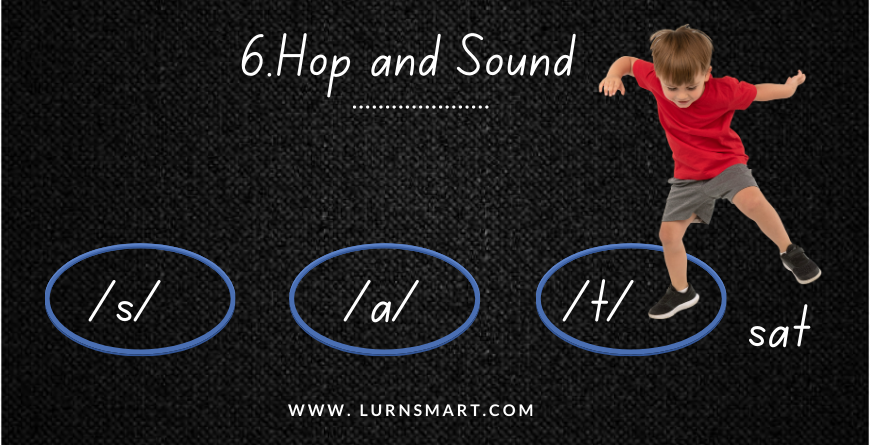
Hop and sound is one of our son’s favorite blending sounds activities!
Apart from the fun part, this game will give your child lots of opportunities to practice segmenting (that is breaking down a word into sounds) as well as blending (which is putting sounds together) in a word.
There are a couple of variations to this game, just pick the one that works for you!
Things you need:
- Chalk/hula hoop/letter mat
Instruction:
Draw circles or place a hula hoop depending on the number of letters in the word that you intend to use.
Simply stretch out and say the word.
Let your child identify all the sounds in the word and hop into each hoop/circle and say the corresponding sound and then hop out and say the word.
Example:
If you are using a letter mat, let your child listen to the word and determine the sounds in the word, and then hop to the sounds in the correct order to spell the complete word.
If you don’t have a letter mat, you can use sticky notes or simply write letters on the floor using chalk.
Tips to Overcome Common Blending Difficulties in Kids:
As I mentioned at the beginning of this post, some children understand the concept of blending easily while others might need some extra help and practice.
However, there are some children, who even after mastering all the 44 Phonics Sounds in English, struggle a lot to blend simple 3-letter or 4-letter sounds to read.
A common reason for this reading difficulty is that these children might have learned the wrong pronunciation of sounds.
You see, the 44 sounds in English are commonly grouped into the below categories:
- Voice vs Unvoiced sounds
- Continuous vs Stop sounds
A common mistake that many parents, including some teachers and phonics instructors, do is, teach unvoiced sounds as voiced sounds and continuous sounds as stop sounds and vice versa.
When children learn to pronounce sounds incorrectly, blending the sounds smoothly to form words becomes a real challenge.
Let’s see some examples!
The sound that the letter S makes is /s/ and not /suh/. This is because the sound /s/ is a continuous sound, meaning, it is said for a couple of seconds. But when the schwa sound /uh/ is added at the end, the sound /s/ is no longer a continuous sound as it is supposed to but instead sounds more like a stop sound /suh/.
Similarly, the sound that the letter T makes is /t/ and not /tuh/. This is because the sound /t/ is an unvoiced sound, meaning, no sound except the sound of air pushing through the mouth should be heard. But when you add the schwa sound /uh/ at the end, it becomes a voiced sound /tuh/.
Some of you might argue that this is no big deal coz’ you might have seen many children get away with learning incorrect sounds.
I agree!
Those children might get away with reading simple 3 letter words like SAT by mispronouncing the sounds as /suh/ /a/ /tuh/.
But have you ever wondered how these children manage to do the wrong sounds but say the correct word?
Here’s how!
Those children are so used to repeating the sounds and the word that they start reading the word ‘out of memory’ just like how we learned to read by memorizing word spellings back in school.
The only difference is, those children say the incorrect letter sounds /muh/ /a/ /tuh/ instead of saying the letter names m-a-t.
The real challenge for those children will arise when they move on to decoding words that are longer and unfamiliar like the word ‘masks’.
Coz’ how can a child arrive at the word ‘masks’ if he or she pronounces the sounds like this— /muh/ /a/ /suh/ /kuh/ /suh/?
You see, what I mean?
The whole purpose of phonics teaching is to empower the child to read independently, accurately, and fluently!
But when a child says the wrong sounds, reads out of memory and does not blend sounds to read, the whole purpose of teaching phonics is not met!
So remember!
Just like how we cannot reach our destination if we board the wrong train, children cannot get the right word if they blend incorrect sounds.
Hence, it is so crucial to teach the correct pronunciation of sounds to your child.
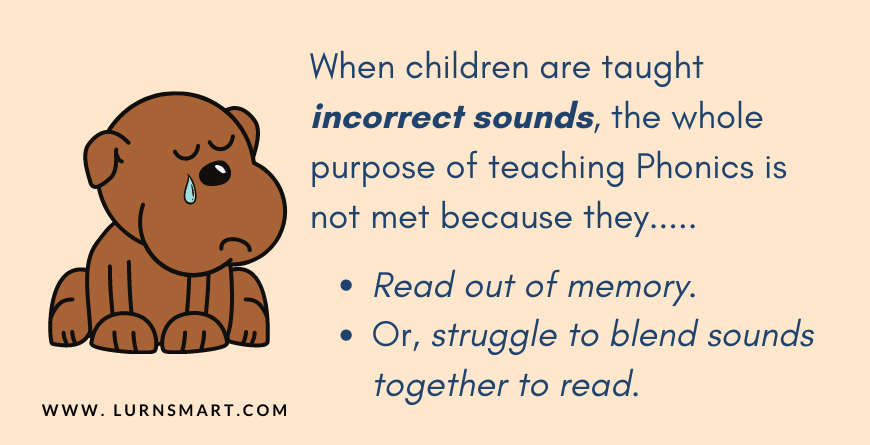
I hope you found the tips and the 6 blending sounds activities shared in this post useful!
If you did, don’t forget to share it with your friends coz’ sharing is caring 😉
Final Notes:
If you are supporting your child to read at home, then you might want to read my blog post Teach Your Child to Read Using Phonics: The Ultimate 7-Step Guide for step-by-step instructions and all the necessary resources that you might need to help your child read and spell easily!
If you are looking for a kid’s reading program, I welcome you to join our LURN Phonics Kid’s Reading Program which is a step-by-step parent-led program that is designed to help your child read and spell fluently and efficiently!
To take up this program, you do not need any prior phonics knowledge or teaching experience!
Everything is so simplified for you that all you need is a playful attitude and the enthusiasm to set aside 10-15 minutes a day to teach your child to read!
The best part is, our reading program is multisensorial and fun-based so no more tears while learning to read but lots of fun and play!
So go ahead and check out our LURN Phonics Kid’s Reading Program and I cannot wait to help you help your little one become an amazing reader and speller 🙂
You may also like

